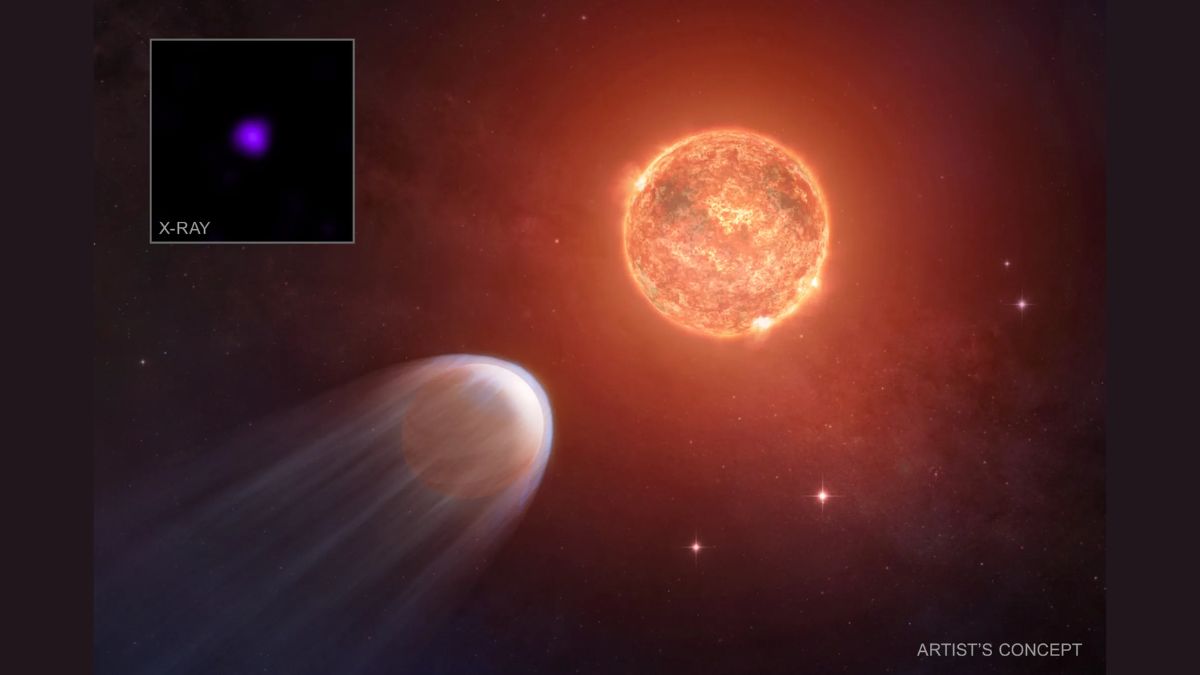Science
Young Exoplanet TOI 1227 b Loses Atmosphere Under Stellar Assault

NASA’s Chandra X-ray Observatory, in collaboration with the Hubble Space Telescope, has identified a young exoplanet, known as TOI 1227 b, that is rapidly losing its atmosphere due to intense stellar radiation. Located approximately 8 million years from formation, this Jupiter-sized planet orbits a faint red dwarf star and is undergoing significant atmospheric erosion.
The powerful X-ray emissions from the star are stripping away TOI 1227 b’s thick gas envelope at an alarming rate. Research indicates that this planet is losing an amount of gas equivalent to Earth’s entire atmosphere roughly every 200 years. According to scientists, the planet’s atmosphere “simply cannot withstand the high X-ray dose it’s receiving,” leading to rapid changes in its structure.
Insights from Observational Data
The study utilized data from the Chandra X-ray Observatory alongside earlier observations from the Hubble Space Telescope to analyze TOI 1227 b’s atmospheric conditions. This planet orbits its star at an extremely close distance, much closer than Mercury orbits the Sun, making it about a thousand times younger than Earth. The star’s intense X-ray radiation is depicted in computer simulations as a blue tail of gas streaming off the planet, illustrating the ongoing atmospheric loss.
Remarkably, if current conditions persist, TOI 1227 b could eventually transition from a gas giant to “a small, barren world.” This process, known as photoevaporation, highlights the significant impact of stellar radiation on planetary evolution.
Stellar Radiation and Planetary Evolution
The findings emphasize the critical role of high-energy stellar radiation in young planetary systems. Intense X-rays and ultraviolet light from active young stars can heat and subsequently blow away a planet’s atmosphere. Co-author of the study Joel Kastner notes that understanding exoplanets necessitates accounting for high-energy radiation such as X-rays. He likens the star’s output to “a hair dryer on an ice cube,” illustrating how the radiation gradually erodes the gas off the planet.
This phenomenon could explain why many intermediate-sized exoplanets appear to end up smaller or are stripped down to their core. As scientists continue to explore the dynamics of exoplanets like TOI 1227 b, these observations provide a rare glimpse into the formative stages of planetary evolution, shaping our understanding of how stars interact with their orbiting worlds.
The research contributes valuable insights into the processes influencing planetary atmospheres and their long-term survivability in the cosmos, paving the way for future studies in exoplanetary science.
-

 World5 months ago
World5 months agoSBI Announces QIP Floor Price at ₹811.05 Per Share
-

 Lifestyle5 months ago
Lifestyle5 months agoCept Unveils ₹3.1 Crore Urban Mobility Plan for Sustainable Growth
-

 Science4 months ago
Science4 months agoNew Blood Group Discovered in South Indian Woman at Rotary Centre
-

 World5 months ago
World5 months agoTorrential Rains Cause Flash Flooding in New York and New Jersey
-

 Top Stories5 months ago
Top Stories5 months agoKonkani Cultural Organisation to Host Pearl Jubilee in Abu Dhabi
-

 Sports4 months ago
Sports4 months agoBroad Advocates for Bowling Change Ahead of Final Test Against India
-

 Science5 months ago
Science5 months agoNothing Headphone 1 Review: A Bold Contender in Audio Design
-

 Top Stories5 months ago
Top Stories5 months agoAir India Crash Investigation Highlights Boeing Fuel Switch Concerns
-

 Business5 months ago
Business5 months agoIndian Stock Market Rebounds: Sensex and Nifty Rise After Four-Day Decline
-

 Sports4 months ago
Sports4 months agoCristian Totti Retires at 19: Pressure of Fame Takes Toll
-

 Politics5 months ago
Politics5 months agoAbandoned Doberman Finds New Home After Journey to Prague
-

 Top Stories5 months ago
Top Stories5 months agoPatna Bank Manager Abhishek Varun Found Dead in Well









